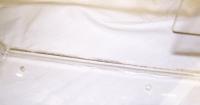ClearPC, C3 and BeanTech: The Clear Chassis Comparison
by Kristopher Kubicki on March 15, 2003 3:14 AM EST- Posted in
- Cases/Cooling/PSUs
Overview
As we mentioned earlier, there are several things to look for in a clear chassis independent from the specific models we are analyzing today. Here are the major items you should look for:
Assembly: Most manufacturers will label very clearly if the acrylic is molded. Unfortunately, the English language permits two very different interpretations of this word. The highest quality acrylic components are assembled from liquid acrylic being poured into a mold. This results in no stress fractions and typically comes with the highest price. ‘Molding’ also refers to the process of bending a warmed acrylic sheet to create the structural components of the case. Typically, the latter instance is what manufactures refer to on their product sheets.
Cut: About half of the clear cases we have seen are laser cut, while the rest are cut with more conventional methods. When cutting acrylic, traditional cutting techniques employed on steel and aluminum become practically unless. If heated too much, the Lucite or other material melts down to a resin, which often beads and bubbles creating uneven cuts. If you see bubbles on the edges, you can be pretty sure the case is not laser cut. The truth holds visa versa as well; if you see a case that does not mention it is laser cut, it most likely will have bubbles in the construction.
Bay mounting: Again, about half of the clear chassis we have seen (and not just the ones in this review), employ a single 5.25” bay column in the front. Usually, this entire bay is removable in order to allow you to mount 3.25” devices with the aide of metal extenders placed in between the bay walls and the drive itself. While practical, this method generates excessive work.
Cleaning: With any clear case, cleaning your case will soon constitute a new level of importance. Our lab may not be the largest marvel of tidiness, but a stray fingerprint on the side of an acrylic case looks incredibly unsightly. Some cases come with rubber gloves for installation, but most do not. If you have a pair lying around, we suggest using them. A little bit of extra work during the installation goes a long way afterward.











0 Comments
View All Comments